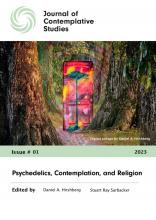Explore Special Issue #01: Psychedelics, Contemplation, and Religion

Psychedelics are now enjoying a resurgence of both popular and scientific interest due to the rigorous documentation of their therapeutic potential. While psychedelics induce short-term alterations of brain chemistry, their long-term benefits foremost arise from the psychedelic subjectivity of patients, most of whom characterize it as among the most profound religious or spiritual experiences of their lives. Regardless of the “epistemic risks”, uncorroborated insights, and unverifiable visions, it is the psychedelic projection of the individual into the depths of the profound that catalyzes personal transformation, which is now not only qualified but quantified in many studies.
As the so-called “second-wave psychedelic movement” gathers momentum, critical perspectives from the humanities have an important role to play in understanding and interpreting the use of psychoactive substances in both historical and contemporary contemplative practice. In this special issue, we examine the role of psychedelics across a range of religious contexts and reflect on the larger philosophical and interpretive frameworks utilized in contemporary research. As such, this work offers more substantive and legitimate historical and methodological foundations for scientific research while contributing to a field that has been, due to its often-controversial nature, ignored or obscured in humanistic scholarship on contemplative practices.
Ultimately, these essays negotiate the extreme views that often divide psychonaut enthusiasts from the psychedelically naïve, where psychedelics are either “everywhere” or “nowhere” across the diversity of religions and contemplative practices, and the subjective insights of psychedelic experience are either unquestionably authentic or merely hallucinatory. The objective is to provide more balanced, measured, nuanced, and accurate accounts of the significance of psychoactive substances in religion and contemplative practice. These essays also provide a foundation for thinking critically and strategically about the ways in which scholarship that addresses the role of psychedelics can contribute productively to our understanding of the religious, therapeutic, and recreational applications of such substances in our contemporary context.
Daniel A. Hirshberg, University of Colorado-Boulder
Stuart Ray Sarbacker, Oregon State University
Texts in this subcollection
The psychoactive plant Datura metel appears across a range of traditions in premodern South Asia preserved in texts. Among those traditions is the form of tantric Buddhism (Vajrayāna) located in the yoginī tantras. In Vajrayāna works, the plant is most prominently used in instructions for bringing about one or more of the magical acts (ṣaṭkarman). This paper explores the possibility that datura was consumed for its hallucination-inducing potential by considering how the plant was viewed and used in premodern South Asia through an ethnobotanical approach to relevant texts. I argue that the material potency of the plant as a dangerous poison, well established in Sanskrit medical literature from an early period, gave it a magical potency that made it a favored ingredient in several hostile magic rites (abhicāra) found in the yoginī tantras. I suggest that the line between material and magical is an inappropriate distinction to draw when examining these tantras, and that the most responsible way to approach the use of psychotropic plants in a premodern culture is by examining what actors from that culture said about the plant rather than relying on our existing knowledge of the effect of that plant.